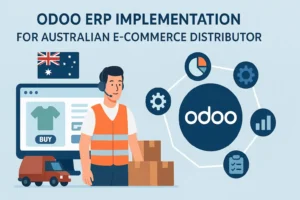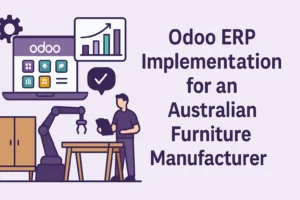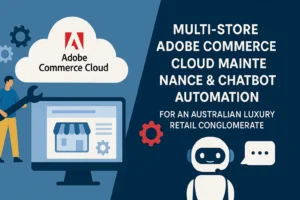
Multi-Store Adobe Commerce Cloud Development & Chatbot Integration for a US Fashion Retail Group
Project snapshot
| Role | Key Capabilities |
|---|---|
| Project title | Multi-Store Adobe Commerce Cloud Development with AI Chatbot and Unified Product Catalog |
| Industry/Sector | E-Commerce / Fashion & Apparel |
| Region | United States |
| Engagement Model | Continuous Development + Managed CloudOps |
| Duration | 9 Months + Ongoing Support |
| Project Scale | 4 Brand Stores |
Client & Project Brief
Client Overview:
A prominent US retail group managing multiple fashion brands sought a unified digital commerce foundation. Each brand ran a separate Magento instance, increasing maintenance overhead and diluting analytics visibility.
Project Objective:
To consolidate all brands under Adobe Commerce Cloud as multi-storefronts, enable shared infrastructure and AI-powered chatbot for support, and introduce automated CI/CD with real-time analytics.
Challenges
- Four separate Magento codebases and inconsistent UI/UX
- Slow deployments and manual version upgrades
- High operational cost from duplicated extensions
- Absence of unified customer support or live-chat automation
Solution Delivered
- Developed multi-store architecture within one Adobe Commerce Cloud environment, each with localized branding and shared backend
- Created modular design system for rapid brand rollout and consistent UX
- Integrated ChatGPT-based AI chatbot via Azure OpenAI APIs for 24×7 product assistance, order tracking, and FAQ automation
- Configured Adobe Cloud Manager pipelines for automated builds and blue-green deployments
- Centralized order and customer data for cross-brand loyalty analytics via Adobe Analytics + Power BI
- Deployed Redis, Varnish, and Cloud CDN for high-speed caching
Our Approach
| Phase | Description |
|---|---|
| Discovery & Design System Setup | Mapped all brand UIs and unified style guide into modular components |
| Architecture Definition | Multi-store setup with shared catalog and payment gateways |
| Development & Integration | Built custom chatbot service using Azure Bot Framework + ChatGPT API |
| CI/CD Implementation | Automated deployment pipeline and staging QA environments |
| Optimization & Support | Monitoring, A/B testing, and feature releases via sprint cycles |
Technology Stack
| Category | Tools & Platforms |
|---|---|
| Commerce Platform | Adobe Commerce Cloud 2.4.6 |
| Frontend | React PWA Studio, Tailwind UI, GraphQL |
| Integrations | Azure OpenAI Chatbot, Adobe Analytics, Power BI, Stripe, PayPal |
| Automation & CI/CD | Adobe Cloud Manager, GitHub Actions |
| Monitoring | New Relic APM, Azure Monitor |
| Security | PCI-DSS, Azure Key Vault, MFA, reCAPTCHA v3 |
Key Results & Metrics
| Metric | Before | After | Impact |
|---|---|---|---|
| Deployment Frequency | Quarterly | Weekly | 4× Faster Releases |
| Avg. Page Load | 4.6s | 1.4s | 70 % Faster |
| Support Response Time | 12h | Instant via Chatbot | 100 % Real-Time |
| Infra Cost | 100% | 65 % | 35 % Savings |
Client Testimonial
“Rigel unified our brands and automated customer engagement. The AI chatbot and multi-store design cut operational costs while elevating user experience.”
— VP Digital Commerce, US Retail Group
Engagement Highlights
- Team Size: 9 (Architect + Developers + AI Engineer + QA + PM + DevOps)
- Delivery Model: Hybrid Offshore with Weekly US Sync
- Compliance: PCI-DSS | GDPR | CCPA
- Benchmark: < 1.5 s load @ 15 K concurrent users
Where Intelligent Conversations Empower Fashion Commerce
Email: presales@rigelnetworks.com
Locations: US | India













